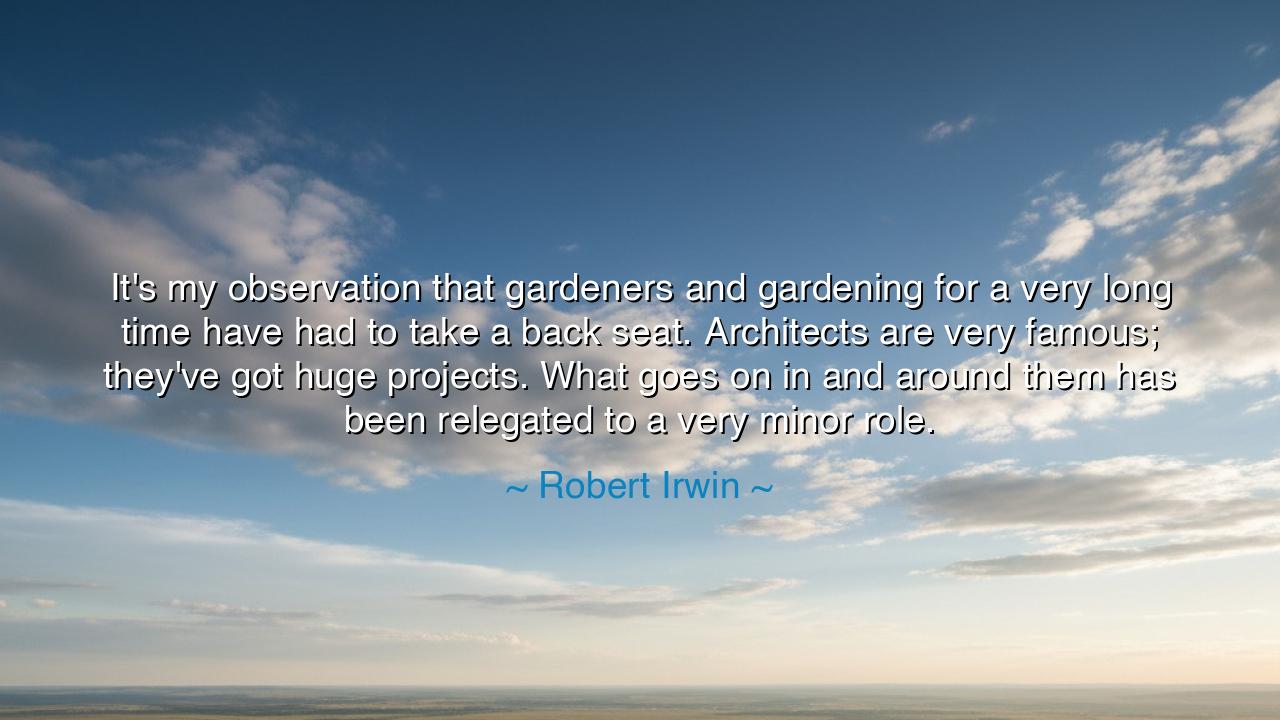
It's my observation that gardeners and gardening for a very long
It's my observation that gardeners and gardening for a very long time have had to take a back seat. Architects are very famous; they've got huge projects. What goes on in and around them has been relegated to a very minor role.






“It’s my observation that gardeners and gardening for a very long time have had to take a back seat. Architects are very famous; they’ve got huge projects. What goes on in and around them has been relegated to a very minor role.” — in these reflective and powerful words, Robert Irwin, the American artist and pioneer of the “Light and Space” movement, speaks not only of the imbalance between gardening and architecture, but of a deeper truth: that in the noise of human creation, the quiet wisdom of nature has been too often forgotten. His lament is not merely about fame or recognition; it is about reverence — about how humanity, in its hunger for monument and mastery, has overlooked the living artistry that grows beneath its very feet.
The origin of this quote lies in Irwin’s lifelong exploration of perception, space, and the human relationship with the environment. A visionary who transformed the way art interacts with nature, Irwin sought to erase the boundaries between the man-made and the organic. His works, such as the Getty Center Central Garden, are not just landscapes — they are living dialogues between stone and soil, between structure and spirit. Through this quote, he gives voice to a truth that had long been overshadowed: that gardeners — those humble stewards of the earth — are artists in their own right, shaping beauty not with steel or marble, but with sunlight, water, and time.
To understand his meaning, we must first recognize what he contrasts. The architect, standing tall before his blueprint, envisions permanence — walls that endure, towers that defy decay. His creations are seen, celebrated, and remembered. Yet the gardener, whose canvas is the living world, works with impermanence — plants that bloom and wither, seasons that rise and fall, soil that never stays still. His art is alive and changing; it requires not dominance, but partnership. And therein lies its sanctity. The architect commands; the gardener listens. The one conquers the land; the other communes with it.
The ancients, however, knew a different truth. In Babylon, one of the wonders of the world was not a temple nor a tower, but the Hanging Gardens — a marvel of green suspended in air. In China, the scholar-gardeners shaped landscapes that were meant not for power, but for contemplation. And in Japan, the art of the Zen garden revealed how even a few stones and raked sand could reflect the infinite. These ancient masters understood what Irwin mourns — that gardening is not secondary to architecture, but its soul. Without the living world to soften its edges, architecture becomes a monument to isolation. Without the green, the gray grows cold.
In his observation, Irwin reminds us that the garden — that sacred space where man and nature meet — has been “relegated to a minor role.” This is not just a critique of art, but a mirror for the human spirit. We too, in our own lives, have often elevated structure over substance — achievement over growth, form over life. We build careers, reputations, and walls, but forget to tend the gardens of our hearts, our relationships, our connection to the natural world. Like architects of ambition, we forget the gardener’s patience — that beauty cannot be forced, only nurtured.
Consider the story of André Le Nôtre, the 17th-century designer of the gardens of Versailles. Though Louis XIV’s palace stands as a symbol of royal grandeur, it is the gardens — vast, harmonious, alive — that capture the soul. Le Nôtre understood that architecture might represent power, but gardening expresses order, balance, and grace. His work endures not because of its scale, but because it breathes. Irwin’s words echo the same truth — that the gardener’s art, though often unseen or undervalued, is what gives spirit to the world humanity builds.
From this, my child, take a lesson of humility and vision. Remember that the greatest creations are not always the ones that stand the tallest, but those that live and move and change with time. In your own pursuits, do not seek only to build, but to cultivate. Be both architect and gardener — design with purpose, but allow for growth. Build your structures, but leave room for the wildflowers of spontaneity and grace to take root. For every life must have its walls and its windows, but it is the garden within that brings light and air to the soul.
Thus, as Robert Irwin reminds us, let us restore the balance. Let the gardener once more walk beside the architect; let the living world be honored as the foundation of all creation. For when we remember to care for what grows — the trees, the soil, the unseen roots beneath our feet — we remember, too, the gentleness within ourselves. And only then will our works, our homes, and our hearts cease to be monuments of stone, and become, instead, living sanctuaries of beauty and peace.






AAdministratorAdministrator
Welcome, honored guests. Please leave a comment, we will respond soon